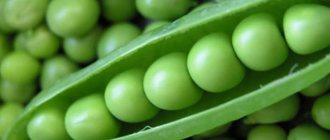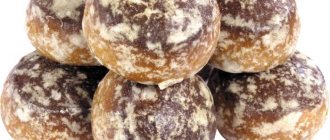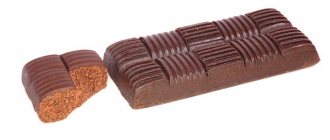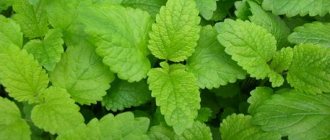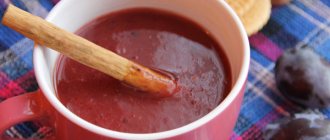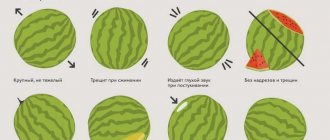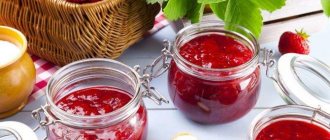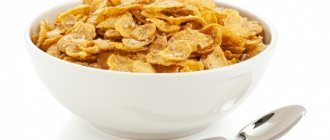Baking for nursing mothers: debunking myths
There are still many myths surrounding nutrition during breastfeeding, which prevent a nursing woman from eating fully and enjoying motherhood due to constant restrictions. This also applies to baking.
Sugar, butter and eggs, mandatory attributes of any baked goods, are unacceptable during breastfeeding.
In fact, you can eat all of these foods while breastfeeding. The main thing is to make sure that the baby tolerates them well. The main danger lies in chicken eggs, since the protein is a strong allergen. But even if the baby has a negative reaction, a chicken egg can be successfully replaced with a quail one. There is practically no risk of allergic reactions in this case. Butter, like sugar, can be eaten in moderation from the first month of breastfeeding. In reasonable doses they will not harm the baby and will not cause any discomfort.
All flour is very high in calories, and during breastfeeding there is already a risk of gaining weight
If there is a time in a woman's life when she can relax her calorie counting a little, it's during breastfeeding. The female body needs more than 600 kcal per day to produce milk. If we add here daily child care and household chores, then the energy costs will be quite impressive.
Nothing bad will happen if mommy eats a piece of pie or a small muffin at breakfast. Of course, you need to keep it in moderation
During breastfeeding, it is better to eat single-ingredient foods without using recipes with many ingredients
In fact, this myth is not without meaning. But this only applies to the introduction of new products into the diet. Under this condition, it is easier to track the occurrence of allergic reactions in a baby to a particular product. If the nursing mother is already convinced that the baby responds well to many foods, you can safely create complex dishes from them, using recipes with many ingredients.
All flour products are harmful for babies because they contain gluten.
Yes, there is some risk of gluten intolerance in newborns, but the risk of such a reaction is less than 4%. Even if the baby is diagnosed with this disease, there are many recipes using, for example, buckwheat or corn flour, which does not contain gluten. Such baked goods will be no less tasty than those made from wheat flour, and will not cause any harm to the baby.
The only thing a nursing mother needs to remember when preparing baked goods is that it is not advisable to use yeast dough. This product often causes bloating and colic in a child, so it is better to replace it with safer analogues.
Can a nursing mother have charlotte?
The first months after childbirth are very important for the mother and her baby.
A woman needs to create all the conditions for her baby to grow normally, gain weight and develop. Nutrition plays a big role in this. With breast milk, elements of the dishes that the mother eats enter the baby’s body. The presence of harmful foods in a woman’s diet can provoke negative reactions in the newborn.
It is impossible to unequivocally answer the question whether charlotte can be consumed while breastfeeding. The fact is that each baby’s body is individual, and therefore is able to react differently to a given dish. Charlotte, prepared from high-quality products according to the classic recipe, is considered safe provided it is consumed in moderation. But there are a number of conditions in which apple pie may be harmful to your health.
Traditional charlotte is prepared from apples and biscuit dough. Baked fruits, unlike raw ones, are allowed for consumption almost immediately after childbirth. Heat treatment makes this product safe for the digestive system of the child and mother. Baked apples contain many minerals (copper, molybdenum, chromium, iron, potassium) and vitamins (PP, B, E, A, C), and fiber. The product also contains pectin, light carbohydrates.
Which baked goods do you prefer: homemade or store-bought?
On the shelves you can find a wide variety of all kinds of buns, pies, and cheesecakes. They look and smell great. Sometimes there is no doubt about the freshness of the products. But is it worth buying them for a nursing woman’s diet?
It is advisable to avoid store-bought baked goods during breastfeeding. Yes, it is tasty, but often it contains ingredients that can harm mother and baby. Preservatives, dyes, flavors, yeast, large amounts of sugar, low-quality vegetable fats - all this can cause allergic reactions and intestinal discomfort in infants.
The only thing you can buy in the store is dryers, oatmeal or biscuits. This product is relatively safe. But you need to carefully look at the expiration dates and read the ingredients so that there are no suspicious components.
An exception may be private small bakeries that make good baked goods from natural ingredients and monitor quality. But you need to prepare for the fact that the price of the products will be quite high and not everything from the assortment will be suitable for the menu during breastfeeding.
To be as sure as possible that the quality of the baked goods is high, the correct ingredients are used, and the product is fresh, it is better to cook at home. Yes, it will take time, but the result is worth the effort.
How to make cookies
Below are recipes for shortbread and oatmeal cookies that are suitable during lactation.
Recipe No1
Ingredients:
- flour - 2 cups;
- a pack of soft butter;
- one yolk;
- powdered sugar - 1 cup.
All ingredients need to be mixed, then kneaded and rolled out the dough, sculpted into figures. Bake at 200 degrees - 10 minutes.
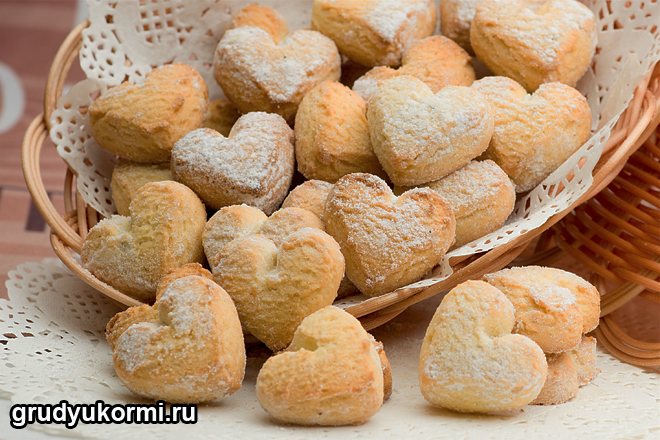
Recipe No2
Ingredients:
- oat flakes - 1 cup;
- flour - a glass;
- eggs - 1 pc.;
- a couple of tablespoons of sugar;
- a little salt;
- 40 gr. butter;
- soda (quench) or 1 teaspoon. spoon of baking powder.
Melt and then cool the butter, add the egg, beat everything. You should get a homogeneous mass. Add sugar to this mixture and stir. Grind the flakes and mix with all the ingredients, add salt, water, baking powder and flour. Then knead the dough and roll it out to a thickness of 0.5 cm; if desired, you can cut out the molds. Bake on parchment at 180 degrees. - 15 minutes, until the baked goods acquire a golden color.
At home, you don’t need to add a lot of sugar and flour to dry baked goods; they will be unsweetened and less fatty. These cookies will be dietary and suitable for any nursing woman.
General recommendations for introducing into the diet and preparing homemade baked goods
To make food enjoyable and not worrying, you need to eat right. This is especially true when breastfeeding. If you follow a few tips below, baking during breastfeeding will become an affordable and safe treat.
- In the first month of breastfeeding after childbirth, it is better to limit yourself to simple and proven dishes, leaving pies and cheesecakes for a later period. This will enable the child to calmly adapt to the new food, and the mother will significantly expand the list of allowed foods, from which she can then prepare delicious baked goods.
- Introducing baked goods into the diet will not be difficult, since it is assumed that all the ingredients have already been tested by the mother and the baby tolerates them well.
- You shouldn’t get too carried away with flour, even if you use healthy recipes. It must be remembered that a lot of carbohydrates in the diet means extra weight for the mother and a risk of intestinal discomfort for the baby.
- Since the dough is a carbohydrate, you need to choose a filling that is protein or contains a lot of fiber - vegetables, fresh fruits and berries, cottage cheese, lean meat, etc. This will help make the dish more healthy and balanced.
- The dough recipe should not contain yeast.
- The amount of sugar and eggs should be minimal.
- If wheat flour is used, it is better to choose the first grade rather than the highest. For premium flour, various chemical bleaches are used to give it a snow-white hue. They can cause harm to the infant’s fragile body.
- Whole grain flour is very healthy, but products made from it do not always bake well. This fact should be taken into account by novice housewives who have little experience working with such an ingredient.
- It is good to replace part of the wheat flour with buckwheat or corn flour, various bran, and also use other useful ingredients.
Desserts for a slim figure
Considering the benefits of apples, let's consider apple desserts that will not be deposited on your thighs and will only bring benefits.
Baked gourmet
This dessert is often recommended by nutritionists to their patients. To prepare you will need apples, cottage cheese, sour cream and cinnamon. You need to remove the core and a small layer of pulp from the fruit. You should now have apple pots. Place cottage cheese mixed with a little sugar and sour cream in these pots and sprinkle cinnamon on top. Grease the baking dish and bake for 20-30 minutes.
Baked with sugar
This recipe is very simple, and the apples turn out so that it is simply impossible to resist them. You need to take a few apples, remove the core from them and pour sugar into the hole. Place the apples in the oven at 180 degrees. In 15 minutes the wonderful dessert is ready.
Apples baked in dough
You will need several apples, sugar, vanillin, puff pastry.
Remove the core from the apples and add sugar mixed with vanilla. You can add cottage cheese, berries or cinnamon. Divide puff pastry (preferably homemade) into equal parts and roll out into squares. Place the filled apples in the center and pinch the corners of the dough at the top of the apple. Bake at 180 degrees for 20–30 minutes. This option can perfectly replace charlotte. There is little dough in it and such a dessert will not bring extra pounds.
Baked for hot
Apples are baked not only as desserts, but also as hot holiday dishes. For example, baked duck with apples is considered a real delicacy. This dish is not only healthy, but also incredibly tasty. You can also bake any meat with these fruits; it will acquire a pleasant aroma and piquant taste. By the way, breastfeeding mothers can not only eat meat, but also need to. And baked meat is much healthier than boiled or fried meat.
Read also:
Can a mother drink pomegranate juice while breastfeeding and how will this affect the baby?
Baking recipes for nursing mothers
Using these baby-safe recipes, you can make sure that homemade baking is delicious and not at all difficult.
Yeast-free dough for pies
This type of dough also does not contain eggs. This makes it the safest and most correct option for breastfeeding.
- Kefir 2.5% – 250 ml.
- Granulated sugar – 2 teaspoons.
- Unscented vegetable oil – 2 tablespoons.
- Salt – 1-2 pinches.
- Wheat flour (grade 1) – about 2.5 cups.
- Baking soda – 2/3 teaspoon.
Heat kefir until slightly warm, add sugar, salt and vegetable oil. Gradually add sifted flour to the resulting liquid, kneading the dough well. Since flour comes in different moisture contents, you may need more or less of it. It is important to add it little by little so that the dough does not turn out too tough.
The baking soda should be approximately divided into 3 equal parts. The dough is rolled out into a layer 0.5-1 cm thick on a board sprinkled with flour, and sprinkled as evenly as possible with one part of the soda. Then the dough needs to be folded 3 times and rolled out again into a layer, sprinkled with soda again and folded 3 times. Repeat the manipulation again. The finished dough should be placed in a warm place for 30-40 minutes.
When the time is up, you can make sure that although no yeast was used, the dough turned out soft and airy. You can start making pies with any filling.
When making pies, do not knead the dough too much, otherwise there is a risk that the products will not rise well.
Liquid yeast-free dough for pizza, open or closed pies
- Kefir 2.5% – 500 ml.
- Salt – 1 pinch.
- Sugar – 1 tablespoon. You don't have to add any sugar at all to get the perfect dietary option.
- Flour – 2 cups.
- Baking soda or baking powder - 0.5 teaspoon.
Mix kefir with salt, soda, sugar and flour in a bowl. It is best to knead this dough with a mixer so that the consistency is homogeneous and without lumps. Flour should be added in portions. The finished dough should be placed in a warm place for 15-20 minutes until air bubbles appear on the surface. Then you can start cooking.
You need to remember that the dough is liquid and does not hold its shape. For open pie and pizza, all the dough is poured into the pan at once and distributed evenly. Then the filling is laid out. If a closed pie is baked, then half is poured out first, then the filling comes, then the second half of the dough. The readiness of this type of dough during baking can be checked with a match.
Apple pie for a nursing mother
Ingredients:
- Cottage cheese 1.5% – 200 g.
- Sweet apples – 2-3 pcs.
- Butter – 80 g.
- Flour (1 grade) – 300 g.
- Chicken egg – 2 pcs.
- Baking powder – 1 teaspoon. You can use a pinch of soda.
- Cinnamon - to taste.
The butter needs to be left at room temperature for some time until it becomes soft. Then beat it with eggs with a mixer. Add cottage cheese and flour mixed with baking powder to the butter and eggs and mix the dough thoroughly. The finished dough should be thin, viscous and elastic.
Grease the mold with a small amount of oil (silicone molds do not need to be greased) and pour in the dough, distributing it evenly throughout the dish. On top of the dough you need to lay thin slices of apples, peeled and seeded. If the apples are sour, you can add to the dough or sprinkle a little sugar on top. If the baby tolerates a spice such as cinnamon well, then you can sprinkle cinnamon on top of the cake for taste and aroma. The cake is baked for 40 minutes in the oven at 180°.
Apples are the most hypoallergenic fruit that can be eaten while breastfeeding from 1-2 months of a baby’s life. It is better to prepare sweet baked goods using this safe and tasty ingredient.
Ingredients:
- Sweet apples – 4 pcs.
- Chicken egg – 3 pcs.
- Granulated sugar – 2-3 tablespoons.
- Semolina – 5 tablespoons.
- Sour cream 10% – 5 tablespoons.
Peel and seed apples. Then grate on a coarse grater. Prepare small muffin tins, grease them if necessary (if the tins are not silicone). Arrange the grated apples among the molds.
Mix eggs with sugar, semolina and sour cream using a blender or mixer until a homogeneous mass is formed. Pour an equal amount of apple batter into each pan. Place the molds in the oven at 180° for 20-30 minutes until golden brown. The readiness of the dough can be checked with a wooden skewer or match.
You can add raisins, cinnamon or a little cocoa to this recipe. These additives diversify the dish, allowing you to prepare completely different-tasting cupcakes using the same algorithm.
Shortbread cookies for lactation
These cookies will not harm the baby, as they do not contain harmful ingredients. It is filling and nutritious. A few of these cookies can replace a snack or become a wonderful dessert. And an increase in lactation will be ensured by fennel seeds, which are included in the recipe.
- Butter – 120 g.
- Granulated sugar – 100 g.
- Vanilla – 1 pinch. You can use a pinch of vanilla sugar or a few drops of extract.
- Salt – 1 pinch.
- Chicken egg – 1 pc.
- First grade flour - ¼ cup.
- Ground fennel seeds – 1 teaspoon.
Soft butter needs to be ground with sugar and egg. Next, salt, vanilla sugar, and fennel seeds, previously ground in a coffee grinder, are added. The flour is sifted and added to the remaining ingredients. A fairly stiff dough is kneaded, from which you need to roll into a sausage, wrap in film and place in the refrigerator for 2-3 hours.
Then the dough is removed from the refrigerator and cut into circles (0.5 cm thick). The circles are laid out on a baking sheet covered with parchment. You can sprinkle the cookies with ground pine nuts on top, which also help increase lactation.
The cookies are baked in the oven at 180° for about 25 minutes. During this time, the dough will acquire a beautiful golden hue.
Baking is normal in a nursing mother's diet. There is no need to give up tasty and nutritious meals. The main thing is not to be lazy, choose good recipes and bake pies, cookies and muffins yourself, and not buy a store-bought equivalent of dubious quality.
Don't be so quick to give up breastfeeding... because of the strict nursing diet your pediatrician insists on. Or maybe it's not so scary? Think about how a child will “try” everything, even through smells, if the mother, in a semi-fainting state, only eats porridge with water? But in all countries except ours, we have never heard of any special diet for breastfeeding. What to do if the sight of baked goods makes your mouth water until your knees tremble?
How to cook charlotte at home
This pie has gained such popularity in our country due to not only its excellent taste, but also its ease of preparation. To bake this masterpiece at home you will need:
- Apples – 4 pcs.
- Baking soda - 1 teaspoon
- Eggs – 4 pcs.
- Sugar – 200 gr
- Flour – 1.5 cups
Read also:
Is it possible for mother to eat onions while breastfeeding?
The first step is to peel the apples and cut them into slices. The core must be removed. After this, you need to beat the eggs with sugar until stiff foam. Separately, you need to extinguish the soda with a small amount of vinegar. Combine the beaten eggs with flour and slaked soda. Grease a baking dish with butter or line it with baking paper. Place apple slices on the bottom and pour the dough evenly.
Bake the pie at 180 degrees for 30–40 minutes. Please note that you need to place the pie in a preheated oven.
How to eat for a nursing mother?
A woman's diet during breastfeeding should first of all be complete and meet the principles of healthy eating. A nursing mother needs to receive proteins, carbohydrates, fats, microelements and vitamins, and fiber.
Moreover, we should not forget that the process of milk production requires 500–600 kcal in addition to those that a woman received from food before pregnancy. And everything that is eaten “for two” will settle as fat deposits on the waist and in other “interesting” places.
For comparison, the WHO textbook offers the following set of products as an additional volume to the usual food:
- 60g of rice (carbohydrates) - 240 kcal, which is about a handful;
- 30g beans (protein) - 120 kcal, which is half a handful;
- 1 handful of vegetables (vitamins, microelements, fiber);
- half a banana (vitamins, microelements, fiber, carbohydrates) - 90 kcal;
- 1 tsp vegetable oil (fats) - 50 kcal.
As you can see, milk production requires nothing at all! As for beans and other products, they are given as an example. Some children may become bloated after a nursing mother tries dishes that contain legumes in their recipes. But there are no products in nature that are 100% likely to cause undesirable reactions in all infants without exception.
Each child is individual, and it is not a fact that yours will somehow react negatively to beans, cabbage, cucumbers or anything else.
In fact, a nursing mother should not starve. This will have little effect on the volume and usefulness of milk. But due to the stress in which the body is in the process of fasting and refusing “goodies,” the production of the hormone oxytocin decreases. And oxytocin is responsible for the secretion of milk from the mammary glands. The less oxytocin, the more difficult it is for the child to receive the treasured mother's milk. So recipes for breastfeeding dishes should be tasty and healthy, delivering gastronomic pleasure to the nursing mother and not harming the baby.
Now about the harm to the child. As mentioned earlier, there are no foods that are absolutely contraindicated while breastfeeding. But according to the observations of nursing mothers, eating some of them can cause: 1) bloating (flatulence) and 2) food allergies. Again, everything is individual. If you are very scared for your child, then here is a list of foods that most often cause bloating:
- whole cow's milk;
- chicken, eggs;
- White cabbage;
- black bread;
- sweets and baked goods made with yeast dough.
Proper nutrition for young mothers after childbirth, diet or pleasure
Allergies are a little more complicated. If you have allergies in your family, then in the first three months of the child’s life it is better to exclude foods traditionally considered allergens from recipes or replace them with something similar. Then try introducing it gradually. But food allergies also occur in children whose pedigree does not include them. This is a so-called transient allergy, which goes away as the immune and digestive systems grow and mature.
So food allergies can be seen in any child to any product. What to do in this case? Identify the allergen and temporarily limit its consumption. But without fanaticism, sitting down to just buckwheat or potatoes. It is very useful to keep a diary, writing down everything that goes into your mouth during the day.
Products that make up recipes for dishes that you want to taste until your hands tremble must be tried separately. For example, if it’s pizza with tomatoes (what would you do without them!), then we take half a tomato, eat it in the morning, so as not to miss anything interesting in the child’s life, and watch the reaction. If all is well, then the next morning you can eat a whole tomato, then two.
The next suspicious product is introduced no earlier than 5–7 days later.
If the baby is covered or swollen, or something else unusual happens that in your opinion is related to food, then the nursing mother can take sorbents (charcoal, smecta, polysorb, polyphepan, etc.) and continue breastfeeding. Avoid the product for the time being.
Often the problem is solved not by complete elimination, but by changing the manufacturer. The fact is that to increase shelf life, manufacturers use various chemical additives that easily penetrate into breast milk. Even hypoallergenic zucchini out of season (for example, in winter) and buckwheat are no exception. And you can get an allergic reaction not to the product itself, but to these additives.
The dangers of homemade baking
Every woman, especially a nursing mother, should remember the possible harm of homemade baking. If your baby is particularly prone to allergic reactions, the sugar content in the cake may cause unpleasant symptoms such as rashes and itchy skin. Also, charlotte can harm a young mother.
Read also:
By consuming black currants while breastfeeding, mothers provide the body with the necessary vitamins.
Unfortunately, homemade baking does not help you lose weight at all. If you want to lose extra pounds after giving birth, it is better to avoid such desserts altogether. If extra pounds are your thing, you should consider alternative desserts.
Baking - is it possible while breastfeeding?
Since we are talking about baking, recipes for its preparation must comply with the principles of a healthy and balanced diet. That is, for the peace of mind of nursing mothers, baked goods should be balanced in composition. It is desirable that there are no potential allergens, “foaming agents”, and especially chemical substances - preservatives, dyes, flavors, stabilizers, flavor enhancers, etc. and so on.
The dough should be yeast-free, made from unbleached flour, without eggs, milk and not cloyingly sweet.
We get carbohydrates from the dough. Where can I get proteins, fats, fiber, minerals and vitamins? By making pies or baked pies with a variety of fillings! And don’t forget that baking is a high-calorie product, so we don’t overuse pies!
Is it possible for a nursing mother to eat pilaf?
Well, as for whether it’s even possible for a nursing mother to bake, sometimes it’s better to eat a piece of the most harmful, coveted cake than to eat your nerves! Remember, strictly denying yourself everything = bad mood = decreased oxytocin levels = difficulties with milk flow.
Now a little about flour for dough. Premium wheat flour is ideal for baking recipes. The dough it makes is airy and rises easily. But everything valuable in the grain is destroyed. It consists of a starchy substance surrounding the wheat kernel, from which it draws energy for growth. Microelements, fats, proteins, vitamins have been removed from it and it contains only carbohydrates.
Manufacturers enrich flour with synthetic additives, which, unlike the natural components of grain, are poorly absorbed by the digestive system. But if you can somehow combat this by diversifying your diet with the missing substances, then there is no escape from those chemical additives that are added to flour for bleaching.
Most often, the flour “improver” used for whitening is benzoyl peroxide E928, which is also used in medicine as part of an ointment for the treatment of acne and other drugs.
Medicines containing this component are not prescribed to pregnant women, nursing mothers and children under 12 years of age. If it is necessary to use the drug, breastfeeding is interrupted. Benzoyl peroxide easily passes into breast milk and can cause allergic reactions. So draw your own conclusions.
As a less harmful option for dough recipes, it is better to use unsightly gray flour of the 1st grade. Whole grain flour, healthy and containing all the valuable parts of the grain, is almost unsuitable for these purposes. Products made from it are heavy, rise poorly and, due to high humidity, appear raw and unbaked. Not for everyone.
Why is yeast dough not recommended for a nursing mother? Instant yeast, when it enters the human intestine, provides a breeding ground for local bad bacteria. As a result, their number increases and beneficial intestinal flora is suppressed. The absorption of B vitamins, which are produced by suppressed beneficial bacteria, deteriorates.
Externally, this process is reflected by bloating, seething in the abdomen, and increased gas formation. The balance of microflora is disrupted, and with excessive consumption of “airy” buns and other baked goods, dysbacteriosis develops and consequences arise - stool disorders, deterioration of metabolism, decreased immunity, etc.
Baking Dough Recipes
For pies, pies, pizza, and much more, you can use an analogue of yeast-free dough - kefir dough. This is how it is prepared.
For pies
- 2–2.5 cup flour
- 1 glass of kefir
- 2 tbsp. spoons of vegetable oil
- 2 teaspoons sugar
- 0.5 tsp salt
- 2/3 teaspoon soda
Heat the kefir slightly without overheating. Add sugar, salt, pour in vegetable oil and mix well.
Add flour gradually, in small portions, to form an elastic dough. If you make it tight, then there will be no air bubbles in it, which will significantly spoil it.
Can a nursing mother eat apples and how does this affect the baby?
Divide the soda into three parts.
Sprinkle the table with flour and roll out the resulting dough (elastic!) to a thickness of 1 cm. Sprinkle the rolled out dough with baking soda (one third) as evenly as possible.
Fold the layer sprinkled with soda in three layers: first 1/3 from one edge, then from the other edge. And also again in three layers. Roll out the resulting bundle again into the same 1 cm layer, sprinkle the second third with soda and fold it in the same way. Roll out, repeat the folding and rolling process again.
In total it turns out - roll out three times, sprinkle with soda three times, fold three times. Run three times to see how the baby is doing. With each subsequent time, the dough should become more porous and fluffier.
Cover the dough and leave it warm to rise for 40 minutes.
After this time, you can make pies. To make them more fluffy and airy, try not to knead the dough too much.
For pies and pizza
For larger baked goods - pies and pizza, nursing mothers can use recipes for jellied dough made with kefir, without eggs or yeast. This dough is prepared very quickly and couldn’t be simpler. And so that it does not seem raw, the baking form can be lightly sprinkled with starch before filling. This is how it is prepared.
All modern mothers know that breastfeeding is the best nutrition for a baby. It is recommended to store it for at least a year. Maintaining a strict diet during this period is very difficult, and it is not necessary.
It is enough for a mother to exclude from her diet those foods and dishes that are poorly tolerated by the baby and can provoke digestive upset or an allergic reaction. There are not so many of them, and as the child grows up and his organs and systems mature, the list gets shorter.
Cooking with eggs and milk
When your baby has already passed the milestone of six months of life, and you have expanded his diet, introduced him to complementary foods, introduced chicken eggs, cottage cheese and butter to the menu, then you can expand your own menu. This also applies to baked goods - still refrain from yeast, but add milk and eggs. Curd casseroles will be especially useful (we recommend reading: recipe for delicious cottage cheese casserole while breastfeeding). Pies and pies will become tastier.
Cottage cheese casserole recipe
Take the following ingredients:
- half a kilo of cottage cheese, preferably low-fat and store-bought, always fresh and from a trusted company,
- two tablespoons of semolina,
- two eggs,
- 50 g milk,
- teaspoon of flour,
- a little raisins (if the baby does not have a negative reaction to them) (we recommend reading: can nursing mothers eat raisins?),
- a tablespoon of butter.
Rinse the dried fruits, rub the cottage cheese through a sieve to make it fluffier. Pour milk over semolina to swell. Separate the whites from the yolks, place the yolks in the refrigerator to cool, then beat them with sugar. Mix the beaten yolks with cottage cheese and semolina, add the whites. Pour the well-mixed mixture into a pre-greased baking dish and place in the oven for half an hour. It can also be prepared in a slow cooker.
Apple pie made from lean dough
You will need for the recipe:
- 200 g of cottage cheese, preferably low-fat and store-bought, always fresh and from a trusted company,
- 100 g butter,
- 300 g flour,
- 2 eggs,
- apples for filling,
- a teaspoon of baking powder or less than a pinch of soda.
Using a mixer, beat eggs with butter, gradually add flour and add cottage cheese. Grease a baking sheet with butter and pour the mixture into it. It should not be completely liquid, but not tight either, but rather elastic. Add peeled, pitted, finely chopped apples. If the apples are sour, you can add sugar. Place in the oven for 40 minutes.
Apple muffins recipe
Ingredients:
- 3 eggs,
- 4 medium apples,
- 4 teaspoons sugar, less to taste
- 5 teaspoons of semolina, high quality and without lumps,
- cocoa,
- 5 tablespoons of sour cream.
Grate the apples on a coarse grater and place in silicone baking pans. Mix eggs with sugar using a whisk or blender, add semolina, then sour cream, stirring. You can add a little quality cocoa to taste. Pour the mixture over the apples and bake in the oven for 20 minutes. The dish is healthy and nutritious, because it does not contain flour or yeast harmful to the gastrointestinal tract. If made in one large baking dish, it can be called a "pudding".
Can a nursing mother have puff pastry?
Baking made from puff pastry is incredibly tender, aromatic, tasty, literally melts in your mouth. Many people love her. But during lactation, puff pastry should be treated with caution. The fact is that it contains a large amount of fat. It is with its help that such a layered texture is created. Fatty foods consumed by a nursing mother can cause digestive problems in the baby. And for those women who want to lose weight and quickly return to their pre-pregnancy form, it is undesirable.
If you really love puff pastry pastries and can’t give it up, you can allow yourself to indulge in them from time to time. But provided it is of good quality and in small quantities. It is better not to use industrially produced dough (frozen or ready-made baked goods). The fact is that it is impossible to check the quality of the products from which it is made. Most often they use margarine and other unhealthy fats. This is unacceptable for a nursing mother. Therefore, you should give preference to homemade baked goods for which you choose.
Try a piece of puff pastry pie when your baby is at least 3 months old. This should be done in the first half of the day. After this, carefully observe the baby’s reaction. If everything is fine, then next time you can increase the portion. If you experience stomach pain, bowel disorders, rashes, etc., then these baked goods should be excluded for now. Try again after 1-1.5 months.
How to choose cookies for a nursing mother?
Homemade baking has an absolute advantage. The owner herself controls the composition of the product. Below are recipes for simple and safe baking that are possible while breastfeeding. A woman herself decides which delicacy to prefer; on the Internet and cookbooks you can find a lot of recipes for delicious and healthy sweets.
We suggest you read: Which throat suckers can pregnant women use?
Dry the oatmeal in a dry frying pan for about 10 minutes, stirring constantly. Oats should not change color! After cooling, the flakes are placed in a dry bag and crushed into flour using a rolling pin. Mix with peeled nuts and grind using a blender or coffee grinder.
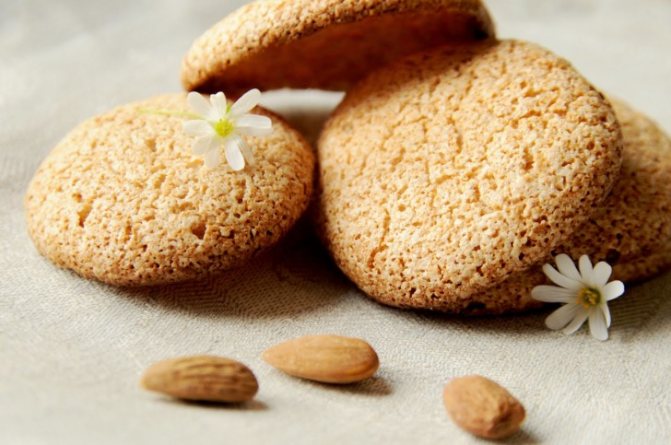
There is a large selection of cookies on store shelves. But it will be much healthier if you cook it at home
The yolks are separated from the whites and ground with sugar until white. Softened butter is also introduced there. Mix thoroughly. Whip the whites separately into a strong foam. Mix everything: yolk-butter mixture, whites, flour with nuts. Then the dough is thoroughly mixed, breadcrumbs are added (about 2 teaspoons).
The baking sheet is covered with parchment, on which the formed products are laid out. You can decorate with dried fruits or nuts. Baking time depends on the thickness of the cookies. You need to focus on the golden color.
Ingredients:
- flour – 2.5 cups;
- vegetable oil (sunflower, olive) – 60 ml;
- drinking water – half a glass;
- sugar – 3 spoons;
- vanilla optional.
Mix everything except flour in a deep bowl. Then add flour and knead the dough for up to 10 minutes - it should be stiff and not sticky. The dough is rolled out into a thin layer, from which cookies are cut using molds, a glass or a knife. The oven is preheated to 200 degrees. The baking tray is greased with a small amount of vegetable oil or covered with baking paper. The cookies are baked for 5 to 10 minutes. The entire cooking process will take no more than 30 minutes.
From this number of components you will get about 400 grams of the finished product. This option is perfect for nursing mothers; it does not contain harmful additives or fats, and is also low in calories.
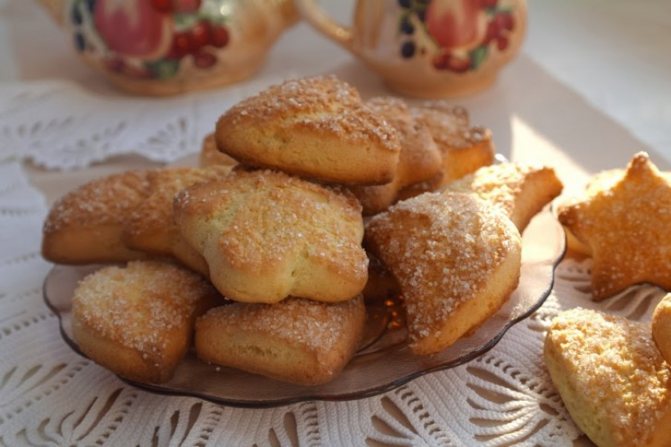
Not only mommy can enjoy fresh homemade cookies, but also loved ones
Ingredients:
- flour – 2 cups;
- sour cream – 0.5 cups;
- butter – 125 g;
- sugar – 1 glass;
- vanilla – 0.5 sachet;
- soda – 0.5 tsp.
Place sugar or powdered sugar, soda, and vanillin in a bowl with flour. The ingredients are mixed and sour cream and butter are added. Knead the dough into a ball, cover with a napkin and put it in the cold for half an hour, then roll it out to 5 mm thick. Use molds to cut out shapes and prick them with a fork. After brushing with beaten egg, place in the oven for 10-12 minutes.
Before considering this pressing issue, let's see what doctors themselves say about carbohydrate nutrition for nursing mothers. Sweet pastries and cookies can be considered the main source of carbohydrates, and therefore energy, so necessary for a woman whose body still continues to work for two, producing natural nutrition for the baby.
Newborn babies are very gentle creatures who, despite their tenacity and strength in their fingers, have a very sensitive body that reacts sharply to the quality of products that are a source of breast milk and various changes in the diet of the nursing mother. The immune and digestive systems of the baby are considered the most sensitive to the composition of the diet.
For the first time, a mother is recommended to “try” cookies 3 months after the start of breastfeeding. If the baby has previously had negative reactions to other, less safe foods in the diet of a nursing mother, then you will have to endure it longer (4-5 months). Moreover, sweet varieties of cookies, pastries with jams and cream can be eaten only six months after childbirth, and in strictly limited quantities. But again, if the child’s body reacts normally to such innovations.
Before you try to introduce this or that cookie into the menu, you need to carefully study its composition. It is better if it is home-baked, which means that the nursing mother will know for sure that the finished product does not contain components that could harm her baby. And we're not just talking about flavorings, preservatives or dyes.
We invite you to read: Dilation of the cervix before childbirth: how it happens, sensations and how to speed it up
The list of prohibited foods also includes mayonnaise and margarine, which are often the main cause of colic in a breastfed baby. And in store-bought baked goods these components are often present, even when butter is included in the list of ingredients, because there is now no strict control over compliance with GOST, as in the Union.
Lean cookies that do not contain fat and a lot of sugar are most easily absorbed by the mother’s body, and therefore her child’s. It is these cookies that can be the first to be tried as “complementary foods”, which actually do not affect the properties of mother’s milk.
But the point is not only about which cookies a nursing mother can eat and which ones she should abstain from. A responsible, standardized approach to including unusual dishes and products for a baby in a woman’s diet during lactation is also important. You need to understand that any innovations, including new products in the diet of a nursing mother, should be practiced according to the principle “caution never hurts.”
If the child does not have allergic manifestations or digestive problems during this time, it will be possible to increase the carbohydrate intake, i.e. eat not a couple of pieces of cookies, but a couple of pieces or more, but in the first half of the day. During the day, you will need to watch your baby carefully to understand his body’s reaction to an increase in the amount of unusual food. If suspicious symptoms appear, it means that it is too early to introduce changes in the diet of a nursing mother.
But fatty shortbread cookies will be taboo for a long time, just like baking with jams or cream, and even more so with chocolate. As for chocolates and chocolate, remember that this product can be given to a child no earlier than he turns 3 years old, because chocolate has a stimulating effect on the child’s fragile nervous system, which results in sleep disturbances and other behavioral abnormalities.
That's how many different nuances you need to take into account to answer the question of whether cookies can be given to a nursing mother. Moreover, no one will give a definite answer to this question. It should be considered on a case-by-case basis, taking into account the pediatrician’s opinion about the child’s body’s reaction to changes in the composition of milk.
We will devote this section of our article to the questions of young mothers who, fearing for the health of their children, are afraid to eat a delicacy familiar from childhood. You shouldn’t deny yourself the pleasure of getting energy from cookies, you just need to decide on the types of baked goods that pediatricians do not prohibit eating while breastfeeding.
What questions can you most often hear among young mothers:
- Can a nursing mother have oatmeal cookies?
Oatmeal is one of the healthiest and easiest to digest cereal dishes, which is included in many dietary tables and is very useful for nursing mothers. And this is not surprising, because oats are a storehouse of useful vitamins (A, E, PP, biotin, B vitamins) and microelements (magnesium, calcium, chromium, silicon, potassium phosphorus and many others).
Moreover, it is also valued for its high fiber content, which promotes better digestion and absorption of food, as well as enzymes that facilitate the metabolism of carbohydrates. Thus, we can say that oats in various dishes will help improve digestion, which is important for pregnant women and nursing mothers, who usually have problems with this.
One day, smart people came up with the idea of using oat flour along with wheat flour in cookies, which not only gave the baked goods a unique attractive taste, but also made them even more healthy. We can talk about the benefits of oatmeal cookies for a long time, but our question is different: can such a delicacy be eaten while breastfeeding, because the composition of the cookies is not limited to just one or two types of flour.
We suggest you read: You can pull out a tooth during pregnancy
What else is included in oatmeal cookies? According to different recipes, different ingredients are added to the dough. For example, butter or margarine, sour cream, eggs, salt and sugar. Or butter (margarine), molasses (or jam), milk, eggs, cinnamon, vanillin and salt.
There are quite a lot of recipes for making oatmeal cookies today, as evidenced by the variety of flavors of these baked goods from different manufacturers. But be that as it may, the cookies contain safe ingredients, if you do not take into account the relatively small amount of margarine. It is this fat of questionable quality that can cause bloating and colic in babies.
If the cookies are made with butter, there is nothing to worry about; you can safely try to gradually include such cookies in the diet of a nursing mother when the baby is 2-3 months old. It would be nice if the cookies weren't too sweet.
- Can a nursing mother have biscuits?
Galette cookies are a special type of baked goods that belong to the category of dietary products. A special feature of this type of cookie is its low fat content, and high-quality natural fats (vegetable oil or butter) are used. Quite often, cookies are baked in water, which makes them even easier to digest and reduces calorie content.
What else can biscuits contain? Milk (instead of water), flour, sugar, starch, soda, sometimes an egg. These are all natural, safe, hypoallergenic products; it’s no wonder that biscuits can be one of the first to be offered to small children to expand their diet.
Recipes for puff pastry for breastfeeding
Sweet puff pastry for a nursing mother
Products:
- flour - 1 kg;
- water (necessarily cold) - 250 ml;
- butter 82% - 500 kg;
- salt - 15 g.
Knead the dough from flour, salt, 2 tbsp. l. soft oil and water. Roll it into a rectangular cake 15-20 mm thick. Spread the remaining butter cut into flakes on top. Fold the edges of the rectangle towards the center, cover them with butter and put them in the refrigerator for 20-30 minutes. Then take it out, roll it out, fold it again, turn it over and roll it out again. Place in the refrigerator for 20-30 minutes. Repeat rolling operations 2 more times. After this, the puff pastry is ready to use.
Yeast puff pastry for a nursing mother
Products:
- flour - 0.5 kg;
- water - 250 ml;
- egg - 1 pc.;
- butter 82% - 200 g;
- yeast - 20 g;
- sugar - 1 tbsp. l.;
- salt - 0.5 tsp.
Dissolve yeast in warm water, add sugar, salt, egg. Mix everything thoroughly. Add flour and knead the dough. Leave in a warm place for 2-3 hours. The dough should increase in size - rise. Roll it into a rectangular shape about 15 mm thick. Cut half the amount of butter into flakes and spread evenly. Fold the layer in half, add the remaining butter and fold again. Roll out the layer to 2 cm thick. Fold into quarters and roll out again. Repeat the operations 2-3 more times. After this, the dough is ready to use.
The general conclusions are as follows:
You can introduce puff pastry into your diet while breastfeeding 4 months after the baby is born, provided there are no negative reactions to this product. Puff pastry has average allergenic activity, but we still recommend introducing it into the diet gradually, and conducting the first tasting in the first half of the day. When breastfeeding, babies most often do not have allergic reactions to puff pastry, with the exception of individual intolerance.
Many women are lovers of sweet and savory pastries, so they are interested in the question of whether pies are suitable for a nursing mother.
The breastfeeding experience is a must for many reasons - the joyful bonding between mom and baby, the health benefits for both mother and baby, and the money savings. A breastfeeding mother's diet should include a wide range of foods to provide her with sufficient energy and ensure successful breastfeeding.
However, many times all mothers have heard controversial comments about eliminating certain foods, which makes adherence to the current diet more stringent. The emphasis should be on the fact that if the child does not have allergic reactions, then the woman should not exclude any food from her diet.
And this is true, but this is only possible when the nursing mother is well aware of those foods that cause discomfort in the baby. What do doctors say about baking? Can a nursing mother have pies?
Most pediatricians tend to believe that baking for a nursing woman will not be beneficial. And this input was made taking into account many reasons. The first thing that needs to be said is that if yeast dough was used to prepare baked goods, then the baby’s body’s reaction to such a product may be colic or bloating. The yeast used to rise the dough causes fermentation in the mother's body, and this process is most likely transmitted to the baby.
If we consider the question, is it possible for a nursing mother to have pies? Here, in addition to yeast, sugar also has a negative effect. Breastfeeding mothers tend to crave foods high in sugar. A mother's increased sugar intake can raise her baby's blood sugar levels.
In addition, according to experts, children who consume large amounts of sugar through breast milk are more likely to experience early dental caries. This is especially true for babies who have been breastfed for 12 months or longer. The good news is that the average number of breastfed babies who suffer from dental problems is significantly lower than the number of bottle-fed babies. Breastfeeding for more than 6 months is not uncommon, but in such cases the mother must monitor her nutrition more closely.
In the first months of a baby's life, nursing mothers have to pay special attention to their menu - any product can be an allergen for the baby or cause digestive upset. But a strict diet during breastfeeding has a bad effect on the well-being and mood of the mother and negatively affects the production of breast milk, since the level of oxytocin is reduced.
By taking certain precautions, you can add tasty and healthy treats to your nursing menu, including baked goods. Dough products should be introduced into the diet gradually, after first monitoring the baby’s reaction to the components of the dish, especially if different types of filling are used.
Charlotte
This is a delicious dessert made from biscuit dough with apples, but is it possible to have charlotte while breastfeeding, will it be beneficial?
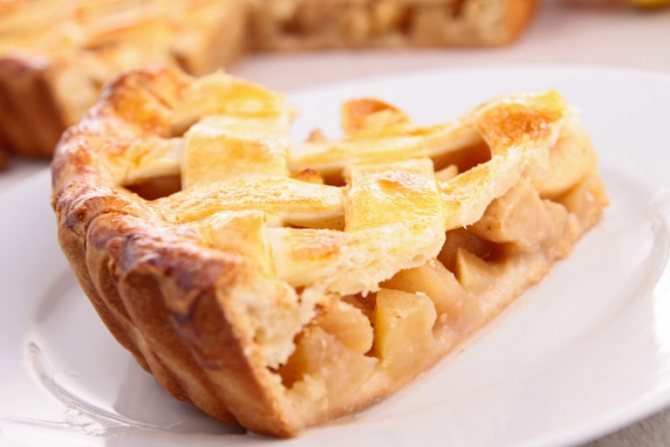
Benefit
Yes, in small portions, charlotte is very beneficial for a woman during breastfeeding. The dough, consisting of eggs, flour and sugar, contains many useful microelements that nourish the brain and energize it.
The benefits of baked apples are as follows:
- they are safe for digestion and do not cause colic or disorders;
- prevent the development of malignant tumors;
- strengthen the immune system;
- improve heart function;
- normalize blood pressure;
- remove toxins;
- eliminate constipation
- improve your mood.
Therefore, those who doubt whether a nursing mother can have charlotte with apples should not limit themselves; in small portions its benefits are obvious.
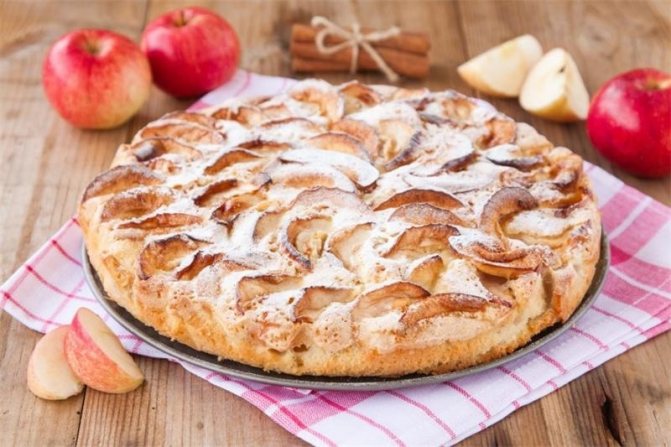
Possible harm
It is undesirable to get carried away with charlotte during breastfeeding if:
- the woman has problems with excess weight;
- in case of individual intolerance to the components of the pie.
It is better to prepare the pie yourself with the addition of a minimal amount of sugar.
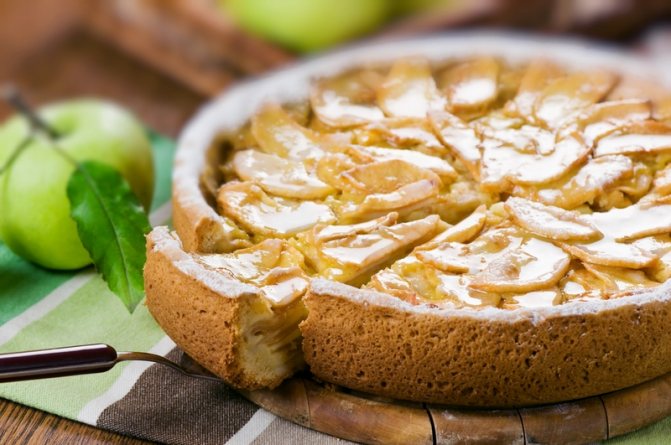
How to properly include in the diet during breastfeeding
For the first time, you can eat a small piece (about 50 grams) in the first half of the day. Then, observe the baby’s reaction for two days. If the outcome is normal, the portion can be increased, but it should not exceed 250 grams. It is better to enjoy dessert no more than 2-3 times a week.
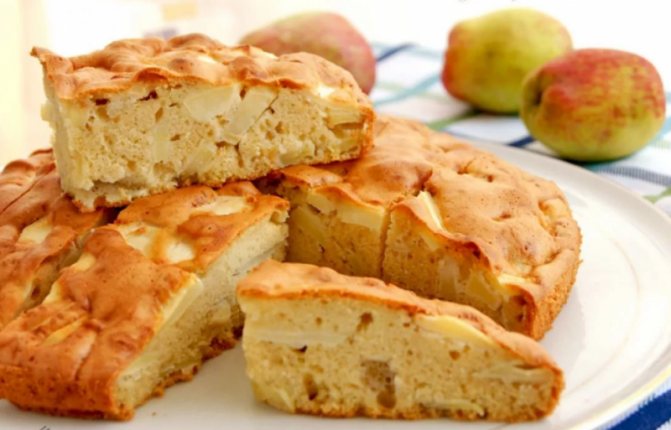
Charlotte recipe for nursing mothers
Even a novice housewife can handle preparing this pie:
- Thoroughly wash and peel 4-5 apples. Cut them into pieces.
- Place them in a silicone mold. If a regular baking pan is used, it is covered with parchment paper, lightly greased.
- Beat 4-5 eggs until foamy, add 1 glass of sugar and beat again.
- In a separate container, quench a teaspoon of soda with lemon juice or vinegar. Add to eggs.
- Mix everything with 1.5 cups of flour.
- Pour the dough over the apples and place in the preheated oven.
- Bake at 230 degrees until fully cooked, which we determine with a toothpick.
Charlotte is not the only delicacy that housewives make from apples. Is it possible for a nursing mother to cook compote, and how to cook it? We’ll find out more about this later.
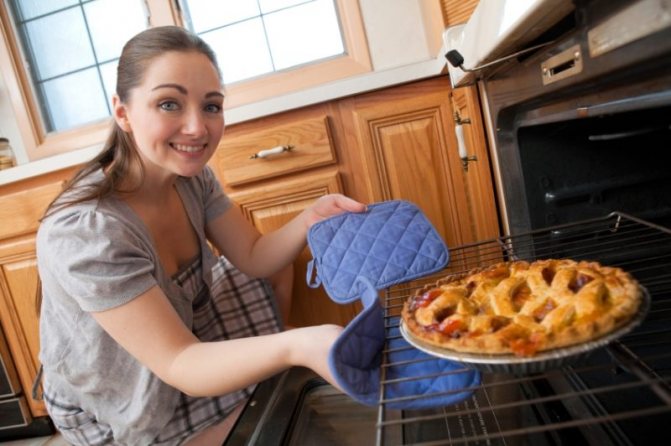
Buy or cook
Pies, cheesecakes and other types of baked goods look appetizing on store shelves. But these products may be unsafe for the baby, since they usually contain artificial flavors and dyes, flavoring additives, and preservatives for long-term storage.
If you nevertheless decide to buy cookies for tea (it is advisable to give preference to oatmeal) or, pay attention to the composition, shelf life of the product and date of manufacture. If there are preservatives, you should not purchase products, since these chemicals are harmful to the health and proper development of the baby.
Private bakeries and bakeries in supermarkets usually offer fresh products - freshly baked rolls, pies and pies.
Potential dangers include:
- the presence of yeast in the dough (for the baby this threatens increased gas formation, abdominal pain, stool upset, allergies);
- increased amount of sugar (not useful for overweight women after childbirth, harmful to the baby’s digestion);
- unknown quality of the filling (it can be made from expired products, contain flavorings and other components harmful to the child).
To be sure that your baked goods are safe, you should prepare them at home using high-quality products that your baby is not allergic to. You can find accessible recipes on the Internet.
Dough is a source of fast carbohydrates. To make the dish as healthy as possible, products containing fiber, vitamins, and proteins are used as pies filling. It can be cottage cheese, cheese, meat or poultry, vegetables or fruits.
Safe dough
To prevent your baby from having a bloated tummy, you should use yeast-free dough made from unbleached flour for baking. It is advisable to use a minimum amount of sugar and eggs.
Ideal baked goods, tender and airy, are made from premium wheat flour. Such products rise well and bake evenly, and look attractive. However, from the point of view of nutritional value, wheat flour is the worst option for preparing dishes for a nursing mother.
High-grade flour, which is made from the starchy substance of grain, has virtually no proteins, vitamins, microelements and fats - these are carbohydrates in their pure form. In addition, such flour is bleached using chemicals that are harmful to the infant’s fragile body.
In particular, benzoyl peroxide is used to bleach flour, which passes into breast milk and affects the baby’s body. You should be aware that drugs with benzoyl peroxide (additive E928) are not approved for use by pregnant and lactating women and children under 12 years of age. This means that it is advisable to refuse “improved” flour.
When breastfeeding, it is allowed to include baked goods made from 1st grade flour in the diet. This flour is suitable for pies and pies; it contains more substances beneficial to the body. Coarser flour, whole grain, is rich in vitamins and microelements, but products made from it do not rise well and do not bake very well.
Nursing mothers are advised to give preference to products made from yeast-free dough. Popular fast-acting yeast creates a favorable environment in the intestines for the proliferation of pathogenic microflora, which suppresses the activity of bacteria beneficial to the body and reduces the absorption of B vitamins.
When the balance of microflora is disturbed, increased gas formation, seething in the stomach, bloating and colic are observed, about the treatment of which you can read in the article at the link. Regular consumption of puffed yeast dough can lead to dysbacteriosis, decreased immunity, and cause metabolic deterioration and weight gain.
Healthy apple recipes for nursing mothers
A mother’s diet during lactation should be as healthy as possible; apple compote during breastfeeding is the best option for a drink.
Apple compote
Apple compote is very useful during breastfeeding. The main thing is to maintain the correct proportions: for half a kilogram of apples, two liters of water and three-quarters of a glass of sugar are enough. The container with water is brought to a boil, then peeled and cut into slices fruits and sugar are added. After 2-5 minutes, remove the pan from the heat and infuse the drink.
Compote for a nursing mother in the first month is not supplemented with other berries and fruits. After a couple of months it can be diversified.
Is it possible for a nursing mother to make apple compote? Of course, yes, if it is made from the freshest ingredients. It is incredibly tasty when served cold.
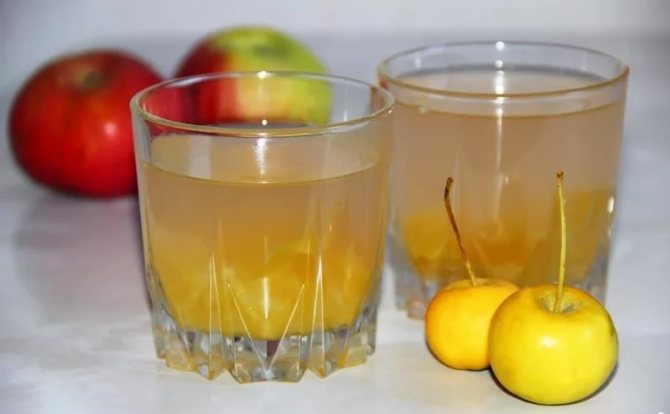
Baked apples
Another delicious dessert recipe:
- Wash the apples, cut off the tops and carefully remove the core.
- Place one teaspoon of sugar inside each fruit. Cover with the removed top.
- Place apples on a baking sheet.
- Bake at 180 degrees for 20 minutes.
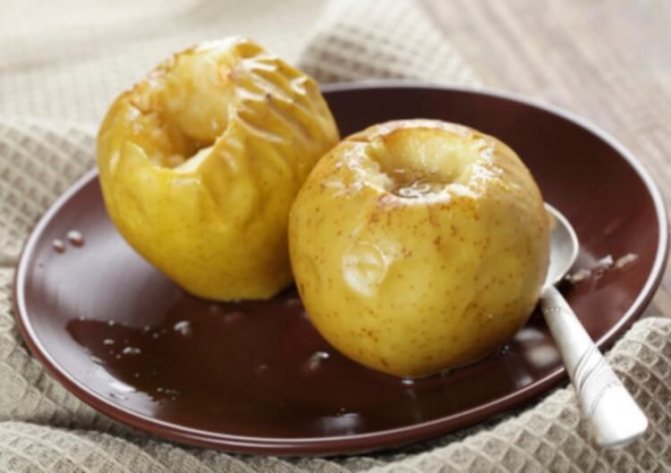
Instead of sugar, you can use honey, jam, dried fruits with cottage cheese or other filling; it is very nutritious and tasty. This dessert will certainly decorate any holiday table.
